Education News from the Museum and Memorial | View in browser
UNDERSTANDING THE GREAT WAR
Teaching WWI With Film

“They Shall Not Grow Old”
Bringing new life to old footage
14‑18 NOW, a project from Museum and Memorial partner the Imperial War Museums, worked with Lord of the Rings director Peter Jackson to restore, and then colorize, footage from the First World War. The ensuing award-winning documentary, They Shall Not Grow Old, looks at the war, providing views of the battlefield and the homefront as the soldiers themselves saw it. 14‑18 NOW also created multi-disciplinary resource toolkits for educators to use the film in the classroom. | Recommended Grade Levels: 6‑8, 9‑12, Adult Learners; Format: Curriculum, Video, Primary Source

The Reel Story of the Great War
Original American footage from the Great War
The National Archives has preserved video resources since the Great War. From footage of the men in training camps and trenches, families at home and women working in factories and on farms, America at war can be viewed over 100 years later.
Read this article and related content on film preservation and Signal Corps video footage to see just what’s available to educators and learners, and how the National Archives has preserved this footage for future generations. | Recommended Grade Levels: 6‑8, 9‑12; Format: Article, Primary Source Video
“Lawrence of Arabia”
Learn the truth behind the famous film
Learn the real story behind the the 1962 Oscar-winning classic Lawrence of Arabia, with the PBS documentary of the same name. Primary sources, lesson plans and age-appropriate language can be found on their companion site that focuses on the Middle East and T.E. Lawrence’s part in the Great War. | Recommended Grade Levels: 6‑8, 9‑12, Adult Learners; Format: Curriculum, Video, Primary Source
Eastern Front in Literature and Film
Lecture by Dr. Larson Powell
Arts can be used to help process trauma and establish collective memory. Good for teacher development, learn more about the relatively unexplored Eastern Front through Czech, Ukrainian, Polish and German films in this enlightening conversation with 20th century film and literature specialist, Dr. Larson Powell, available to watch on YouTube. | Recommended Grade Levels: Adult Learners; Format: Video

“1917”
Teaching with Film
The highly acclaimed Sam Mendes' film 1917 has media abuzz and some interesting ELA and C3 connections. Engage the skills your students need for careers in history with an assignment that has students use primary source photographs, letters, maps and oral histories from the National WWI Museum and Memorial to answer the question regularly asked of our museum professionals, “How historically accurate is the film?” | Recommended Grade Levels: 9‑12, Adult Learners; Format: Curriculum, Video, Primary Source

Western Front at the Cinema
Bringing the War Home
This resource from Facing History investigates how the war was being brought home. Films showed audiences the reality of what was occurring to their loved ones on the Western Front. While the casualties mounted, so too did the public’s interest in learning the true experience in France and Flanders. Governments around the world made sure that information was thoroughly censored, leaving the graphic and sometimes truthful details off the screen. | Recommended Grade Levels: 9‑12; Format: Article, Video, Primary Source
American Film Propaganda in Revolutionary Russia
World War I saw the first mass use of film to record events - and its first significant use as a tool for persuasion. Explore primary sources with in-depth articles by James D. Startt to see an early example of how the U.S. government began to use film to persuade a foreign audience. | Recommended Grade Level: 9-12, Adult Learners; Format: Article, Primary Source
Mary Pickford in 100% American, A Liberty Loan Film. Popular movie actors, like Douglas Fairbanks, Mary Pickford and Charlie Chaplin, created films to help sell Liberty Loans. Click the image to learn more.
Mary Pickford in 100% American, A Liberty Loan Film. Popular movie actors, like Douglas Fairbanks, Mary Pickford and Charlie Chaplin created films to help sell Liberty Loans. Click the image to learn more.
Charlie Chaplin and Liberty Loan
Upper Elementary appropriate and in the public domain, The Bond by Charlie Chaplin is a light 10-minute Liberty Loan appeal. His follow-up film, Shoulder Arms, was a smash comedy classic, considered one of the 10 Great First World War Films by BFI and provides a rich comedic opportunity for primary source analysis. | Recommended Grade Level: All levels; Format: Video, Primary Source
PARTNER SPOTLIGHT

Arlington National Cemetery, the U.S. Military burial ground which includes the WWI burial grounds of John J. Pershing and the Tomb of the Unknown Soldier, is seeking teachers and individuals to test Arlington’s new educational materials in the month of February 2020.
Teachers can use the lesson plans in the classroom, visitors can guide themselves on new walking tours through the cemetery and lifelong learners of all kinds can explore history through curated historical readings. Participants will have access to the new educational materials in return for taking a survey and providing feedback to help shape the future of the Education Program.
If you are interested in this program, please contact usarmy.pentagon.hqda-anc-osa.mbx.anc-education-out-reach@mail.mil for more information.
The United States World War One Centennial Commission and the National WWI Museum and Memorial are dedicated to educating the public about the causes, events and consequences of World War I and we encourage the use of these resources to better understand the Great War and its enduring impact on the global community.
Partners from around the world participate in the Educator Resource Database, some of whom are highlighted in this newsletter.
NATIONAL WWI MUSEUM AND MEMORIAL
2 Memorial Drive, Kansas City, MO 64108 USA | 816.888.8100 | education@theworldwar.org
©2020 NATIONAL WWI MUSEUM AND MEMORIAL


